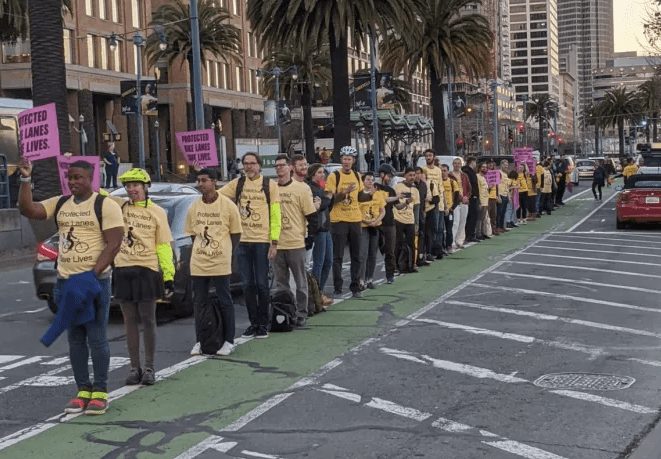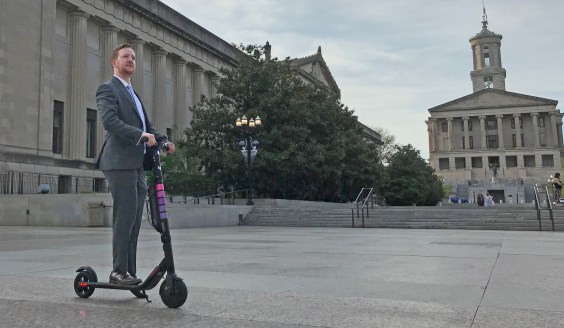Note: GJEL Accident Attorneys regularly sponsors coverage on Streetsblog San Francisco and Streetsblog California. Unless noted in the story, GJEL Accident Attorneys is not consulted for the content or editorial direction of the sponsored content.
Some forty people showed up Monday evening for another People Protected Bike Lane demonstration on the Embarcadero. They donned yellow t-shirts and stood next to speeding cars, trucks and buses to block the Waterbar restaurant from using the bike lane for valet parking.
These demonstrations have gone on for so long around the city, it's easy to forget the bravery and passion it takes to put ones body in the street. Everyone who participates knows that it's just a matter of one scofflaw motorist speeding or not paying attention, and they could end up in the hospital or morgue.
Day-to-day conditions on the Embarcadero are so bad, for now it seems there's no choice but to continue demonstrating. Last night's action only lasted a few minutes, as explained in the tweet below:
The police shut down our ability to fully protect our own. There was visibility and we made our point that we need protected bike lanes once and FOR ALL! Much love to fellow beloved @PeopleProtected advocates who remain fearless and undaunted! pic.twitter.com/0mEdWvrGKG
— Paul Valdez 🚲🏳️🌈 (@paulvaldezsf) February 11, 2020
Lieutenant Pilar Torres, who arrived at the scene shortly afterwards, told Streetsblog the motorcycle traffic cop who broke up the demonstration--the first one that's been stopped anywhere in the city--was "not from our division." He said stopping the demonstration was a mistake, but the demonstrators opted to call it a day regardless.
Torres spoke in simple moral terms: demonstrators have a First Amendment right to demand a better Embarcadero and to stop motorists, such as the Waterbar's valets, from blocking the bike lane. And it's his job to keep everybody safe while they do it, regardless of whether motorists are delayed.
Last month, when Streetsblog wrote about Waterbar valets parking on the bike lane and endangering cyclists, Pete Sittnick, Managing Partner of the joint, told Streetsblog that the Embarcadero needs "...an equitable and fair solution to meet the needs of all the stakeholders."
Sittnick was more stark in Monday's San Francisco Chronicle:
“I have an investment group that’s obviously looking for a return. I have to be able to make money to pay off that investment.” He added: “Let’s say the valet lane went away, and it became just a bike lane. That would hurt me. It would make it less convenient and less accessible. Then people would think about how often they came.”
So an "equitable and fair solution" values profits (from motorists only apparently) as worth the occasional bone fracture, traumatic brain injury, and death. In the same article, the San Francisco Chronicle made it sound as if protecting cyclists on the Embarcadero is enormously complicated. Actually, it's about as simple as it gets. As Torres told Streetsblog:
KEEP. EVERYBODY. SAFE.
Thanks to the documentation of Dale Munroe, it's clear the Waterbar's valet service is putting people in danger. The only moral option is to revoke their valet license. There are other simple steps that can be taken to make the Embarcadero safer while the city works on details for the larger, multi-million dollar "Embarcadero Enhancement Project."
For example, Streetsblog suggested the Port follow Vancouver, British Columbia, which has segregated an area for cyclists on its seawall's promenade (see picture below) using poles, signs, bricks and a few shrubs:
Does that look complicated?
Cyclist are already allowed on San Francisco's seawall promenade, so segregating it won't take an environmental report, or a years-long-study, or complex engineering. It just means swapping out what we see below (in San Francisco) for what they have in Vancouver, seen above.
Or, on the street itself, SFMTA could put in cheap, movable but robust barriers to keep motorists off the existing bike lanes, as was done in Oakland on Clay Street:
Also not complicated.
Today, the Port Commission and SFMTA officials discuss proposals for short and long-term solution to making the Embarcadero safe. It's great that the city is finally moving forward with quick-build protected bike lanes from Folsom to Mission, but as the San Francisco Bicycle Coalition put it in a statement, it's going to take protected lanes "...beyond the current plan in place, and far beyond the Waterbar. A safe and bold solution for the Embarcadero are protected lanes from Pier 39 down to the Ballpark."
The Port, SFMTA, and Supervisor Aaron Peskin need to channel the bravery of People Protected bike lane demonstrators and the moral clarity of Lieutenant Torres. People are dying and sustaining life-altering injuries while morally confused people try to balance public safety against commerce and personal profit. Let's hope at today's meeting everyone involved stops pretending this is complicated--morally, physically, or otherwise--and starts working on making the entire Embarcadero safe.






